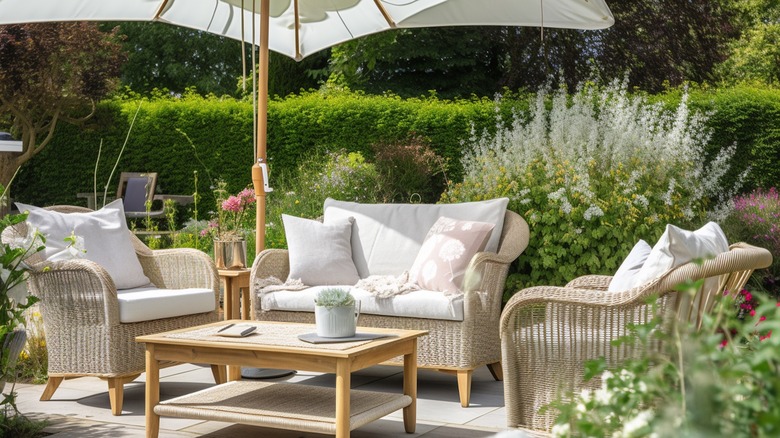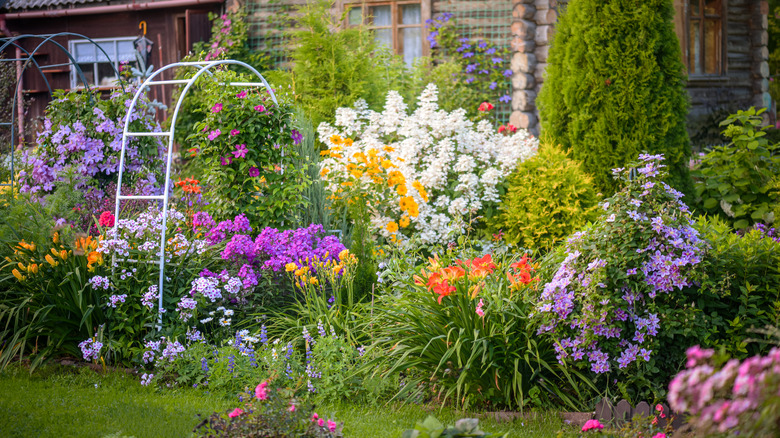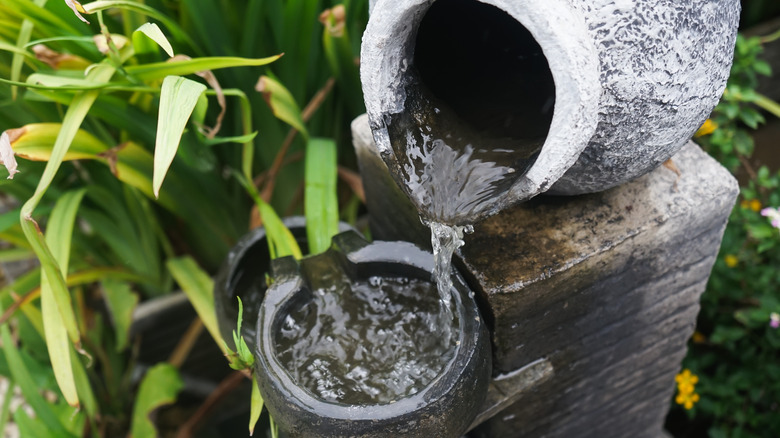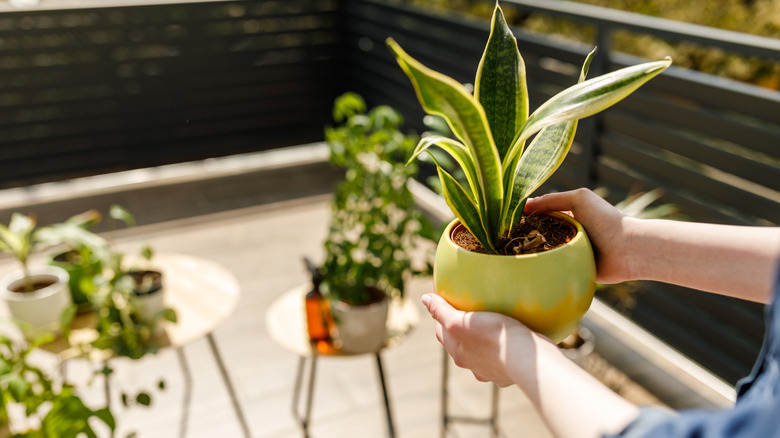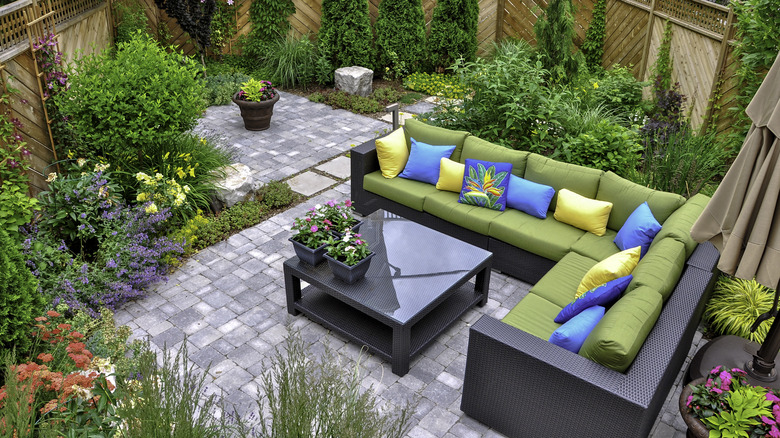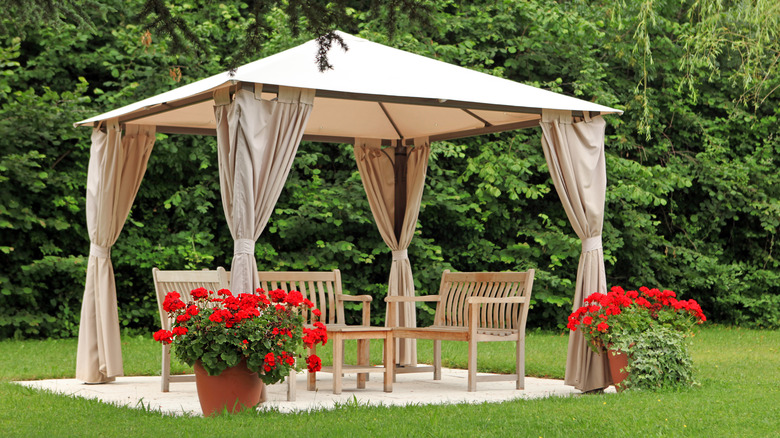Refresh Your Backyard Landscape On A Budget With These Projects
We may receive a commission on purchases made from links.
With warm weather comes the urge to relax in your backyard, but to truly enjoy your time outside, you may want to beautify your space first. However, as anyone who has undergone a few landscaping projects knows, updating your yard can get pricey fairly quickly. Homeowners often spend between $2,600 to $13,700, with an average cost of $8,150, when giving their outdoor space a new look. The cost, of course, depends on the size of your yard and what projects in particular you're tackling. Fortunately, there are a few budget-friendly landscaping projects you can undertake that will give your backyard a refresh without spending thousands of dollars. These include adding certain flowers and plants, DIYing a water feature, including hardscaping, and building an inexpensive pergola.
Working on a tighter budget often requires you to choose your backyard ventures carefully and do a little research on the most inexpensive methods. You should also consider DIYing most of these projects since hiring a professional landscaper also means paying for labor, which typically costs between $50 to $100 per hour, on top of the price of materials. Instead, by finding inexpensive materials and following these budget landscaping ideas that will transform your space, you can create a picturesque backyard that you'll love spending time in during the summer and beyond.
Grow a flower garden
Add a pop of color and some visual interest by dedicating part of your backyard to a flower garden. Hiring someone to do this project can cost up to $5,800, depending on the size of the garden plot. Instead, this is an easy project to take on yourself to save money. A hardware store or a local garden center will have plenty of options, such as a potted rose bush for $20 or ground cover like creeping phlox for $9, both from Home Depot. You can also consider colorful wildflowers to grow in your garden or look for native options in your area.
For a garden that comes back each year without having to replant, look for perennials such as daffodils, tulips, peonies, and daylilies. You can plant these in the spring or fall and enjoy them once the weather gets warm. If you like to be out in the garden and want to be more hands-on, consider growing a flower garden from seeds. The results may take a little longer, but it can also be incredibly satisfying to watch them bloom with your care.
When first planting your garden, you want to take note of the location's relation to the sun. Some flowers prefer full sun while others want a little bit of shade. Notice how much sun an area receives and keep that in mind when choosing your flowers to ensure they get the proper amount of sunlight to provide colorful blooms.
DIY a fountain or small water feature
A water feature or fountain in the backyard instantly creates a feeling of relaxation, but this can be a pretty expensive accent to add to a home. Outdoor water features can cost anywhere from $150 to $11,000 depending on the size and design. Luckily, you don't have to pay a ton of money for this landscaping addition. Instead, you can make your own, and creating garden water features doesn't have to be difficult. Further, if you're on a budget, a DIY fountain is a better option than a small pond that would be more expensive upfront and require more ongoing maintenance down the line.
The main item you need for this project is a submersible water pump. One from Amazon can turn a shallow pool of water like a bird bath into a fountain for $17, while a larger one from Lowes for $24 can be used for a larger feature. From there, you have a variety of ways to build a DIY water feature. You can use ceramic planter pots, buckets, and other large containers. Decorate the space with rocks and paving stones to add some texture and visual intrigue. Not only will doing this project yourself save you money, but it also allows you to customize the piece to your liking.
Add greenery with plants
Similar to adding flowers for color, you can also add plants for greenery. Plants will provide great texture and can turn your backyard into your own private oasis. You can add greenery through potted plants and shrubbery. Shrubs like boxwood are common for landscaping and are often used as edge plants and for topiaries. This is an easy-to-maintain plant that would be a good base for your backyard landscaping. Leafier varieties like holly are great if you're looking for a more natural form and larger leaves. Or, look for blooming shrubs like azaleas and rhododendrons that will provide flowers in the spring or summer and greenery when not in bloom.
Another option is to move some of your houseplants outside during the warmer weather. If you live in a warm climate, container plants like alocasia, philodendrons, and monsteras will soak in the extra sunlight and use it to thrive. Place these plants around a patio or in a vertical garden to create a living wall of plants. Line a deck or patio with potted plants to create an oasis-like space that aids in relaxation. Types with interesting or large leaves, like a banana plant or monstera, will mimic the look of a tropical paradise. Pothos and other vining varieties are good to use in hanging baskets. You can also make them trail around a patio on railings and trellises. Just bring them back inside when the weather gets too cold.
Use hardscaping to make a patio
Adding a patio to your backyard will create an outdoor living space. The cost of materials and professional labor can make building a patio a pretty expensive endeavor, so doing the project yourself and choosing the materials wisely can make this a more budget-friendly backyard project. Brick pavers are a good option because they're relatively inexpensive, costing about $0.50 to $10 per square foot. For instance, French pattern travertine pavers from Travertine Mart cost less than $5 per square foot, depending on how you order them. There are also some tools you may already have for this project like a rake, shovel, level, rubber mallet, and broom. However, you may need to buy a tamper and brick cutter. You'll also probably want to buy landscape fabric, gravel, wood boards, and builder's sand.
The general process of building your own patio requires you to excavate the part of your backyard you want to turn into a patio by removing the grass and dirt. Use 2 by 6-inch pressure-treated lumber to create the border around the edge of the hole and screw them together. Ensure your patio is level, then add the gravel and spread it around. Add the sand, spread it out, and tamp it down. Then, add the pavers, fill in the gaps with sand, and brush out the excess sand. Once the pavers are down, you can add a dining set, chairs, or a grill to create your ideal space.
Add shade with a pergola
By adding a pergola to your backyard, you'll provide yourself with a place to relax that's out of the hot sun. Pergolas are an affordable and stylish backyard upgrade, and they're fairly easy to include in a landscaping design. Building a pergola for your backyard can cost between $2,148 and $6,363 with factors like size, material, and customizations adding to the cost. However, there are plenty of pre-built or easy-to-assemble options under $500 that will add a stylish accent to the space. For instance, Walmart has a steel pergola for $249 and Target has a retractable aluminum one for $350. These can be installed with ease in most common backyard terrains or over an existing patio or deck.
Give a pergola a custom feel by adding white drapery to help block the sun and give the piece an airy look. You can also use vining plants and flowers to create natural shade and add another textural element to the backyard. Underneath, create a small sitting area with patio chairs and chaise lounges that will be perfect for reading, talking, or enjoying a cup of coffee in the backyard. You can also add a dining table to make an area to dine al fresco. Or, add a small fire pit that will allow you to use the pergola at night or roast marshmallows — whatever is within you budget, you can include.
